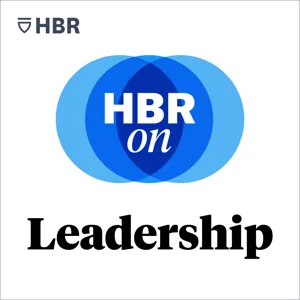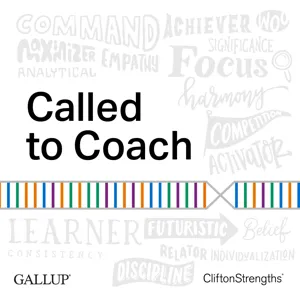Podcast Summary
Understanding team members' strengths and interests: Focusing on individual strengths can lead to better collaboration, increased morale, and talent retention. Start by getting to know team members, delegate tasks based on strengths, and allow team members to excel in their areas of expertise.
To improve team dynamics and productivity, it's essential to understand and appreciate the unique strengths and interests of each team member. Marcus Buckingham, author and head of research on people and performance at ADP, argues that by focusing on individual strengths, teams can collaborate more effectively and increase morale and talent retention. Buckingham suggests starting from day one by getting to know your team members and helping them identify their areas of expertise and passion. By delegating tasks based on strengths and allowing team members to shine in their areas of expertise, you can create a more engaged and motivated team. Buckingham's book, "Love and Work," provides further insights and practical advice on this topic. So, in summary, understanding and leveraging the unique strengths and interests of team members is a key strategy for improving collaboration and productivity in the workplace.
Discipline of team joining for effective teaming: Encourage deeper connections by getting to know team members' passions, strengths, and areas for improvement. Lead by example and create opportunities for team bonding to foster trust and collaboration.
Effective teaming is crucial for organizational success, especially in today's remote and hybrid work environments. Team joining, a discipline that goes beyond administrative onboarding, is essential for team leaders to help new members feel connected and contribute their unique strengths to the team. Team joining involves getting to know team members on a deeper level by encouraging them to share their passions, strengths, and areas for improvement. This fosters trust and collaboration, creating a team where individuals complement each other rather than competing. Encouraging open communication and creating a safe space for vulnerability can help new team members feel comfortable sharing and build strong team dynamics. As a team leader, leading by example and creating opportunities for team bonding can help set the tone for a successful team.
Understanding Colleagues: Assessments and Love Notes: Assessments like Gallup's StrengthFinder and Marcus Buckingham's StandOut reveal team members' strengths. Love notes focus on strengths and foster inclusivity. Regular check-ins and sharing love notes improve collaboration and understanding.
Effective teamwork and understanding colleagues' strengths and motivations are crucial in today's work environment. Tools like assessments and love notes can help reveal insights and foster connections. Gallup's StrengthFinder and Marcus Buckingham's StandOut are examples. Love notes are statements about who we are, what we love most, and where we excel. They focus on strengths rather than comparisons, which can help avoid unproductive comparisons and foster a more inclusive team culture. Regular check-ins and creating opportunities for team members to share love notes can lead to better understanding and collaboration. Organizations should encourage and even require managers to prioritize these activities to create a more effective and engaged workforce. Companies like Cisco have seen significant benefits from implementing regular check-ins.
Weekly check-ins for team engagement and productivity: Regular weekly check-ins between team leaders and team members foster engagement, resilience, and productivity. They provide opportunities for open communication, support, and guidance, and align with human memory and social patterns.
Regular weekly check-ins between team leaders and team members are a powerful tool for fostering engagement, resilience, and productivity. These check-ins provide an opportunity for individuals to share their current projects, challenges, and passions, and for team leaders to offer support and guidance. The weekly rhythm of these meetings aligns with human memory and social patterns, making them an effective way to maintain open communication and build strong relationships within a team. While the ideal frequency may vary depending on the specific circumstances and dynamics of each team, research suggests that checking in once every 11 days is the minimum for achieving positive outcomes in areas such as engagement, resilience, employee turnover, productivity, and performance ratings. Ultimately, these frequent check-ins help create a culture of openness, trust, and continuous improvement, where team members feel heard, valued, and empowered to succeed.
Leadership and Team Size: Effective leadership requires individualized attention, making smaller teams ideal for personal connections and higher engagement, but exceptional communicators and empathetic listeners can lead larger teams successfully.
Effective leadership involves frequent engagement with team members, and the size of a team should not exceed the manager's capacity to give individualized attention. The CEO's number of direct reports is an indicator of a company's commitment to employee care. While some exceptional managers may handle larger teams, the norm is that smaller teams allow for more personalized connections. The hospital example of one nurse supervisor to 60 nurses illustrates this principle, but it's not applicable to all organizational structures. In today's complex work environments, with increasing team sizes and openings, it's crucial for leaders to be excellent communicators and empathetic listeners. The human condition's vast range makes it challenging to love and attend to every aspect of a team, but focusing on individual connections can lead to higher engagement and productivity. Ultimately, the goal is to create an organizational culture where each team member feels valued and heard.
Leveraging team member uniqueness for effective teams: Companies that prioritize individuality and create environments that value team members' unique strengths are better positioned to attract and retain top talent, leading to effective and excellent teams.
Understanding and leveraging the unique qualities of team members is crucial for building effective and excellent teams. This concept is not a new discovery but a fundamental design principle that has been present since ancient times. Companies that prioritize this principle and create an environment that values individuality are better positioned to attract and retain top talent. The army, for instance, organizes its squads around the unique strengths of each member, and the best squad leaders are those who are curious about each person's role and contribute accordingly. In contrast, many organizations fail to recognize the importance of teams and the uniqueness of team members, often leading to a lack of engagement and suboptimal performance. The pandemic has highlighted the need for flexibility and adaptability in the workplace, and companies that want to succeed in the post-pandemic world must embrace this principle and create teams where individuals can bring their unique perspectives and skills to the table. As a potential team member, it's essential to consider joining a company that values and understands the importance of teams and individual uniqueness.
Creating a compelling talent brand for employees: CEOs who value and celebrate individuality see improved engagement and reduced turnover through regular check-ins and fostering a culture of curiosity and personal growth.
CEOs need to adapt to the changed workforce by creating a compelling talent brand that values and celebrates individuality. Companies like Lululemon, which are explicit about their curiosity for employees' goals and aspirations, have seen significant improvements in engagement and reduced turnover. Simple check-ins about employees' passions and how they can contribute to the company have led to impressive results, such as a 67% reduction in turnover and a 77% increase in engagement. Traditional annual surveys are no longer sufficient; companies need to focus on team-by-team improvements for quick and significant changes in important metrics like engagement, resilience, and turnover. In essence, the best CEOs will succeed by embracing a culture that is curious about their employees, fostering a sense of belonging, and allowing for personal growth.
Love fuels growth and success in work: Companies prioritizing employee growth and development will be more competitive, leading to investments in lifelong education, alumni programs, and flexible work arrangements. Shift from standardization to individual recognition and value.
The future of work lies in building organizations that prioritize people's passions and contributions. The speaker argues that love fuels learning, innovation, expertise, and overall work performance. Companies that focus on their employees' growth and development, beyond the scope of their employment, will be more competitive and successful. We can expect to see more investments in lifelong education, alumni programs, and flexible work arrangements. Additionally, there will be a shift away from standardization and conformity, with less emphasis on traditional competency models and rigid performance evaluations. The ultimate goal is to create work environments that recognize and value the worth of individuals, regardless of their employment status.
Shift from traditional HCM infrastructure to prioritizing joy and individuality: Organizations may move towards small, agile teams led by curious team leaders, focusing on individual strengths and passions, fostering creativity, collaboration, and productivity.
The future of work may involve a shift away from traditional human capital management infrastructure, such as feedback systems, cascaded goals, and a focus on ratings. Instead, organizations may prioritize small, agile teams led by super curious team leaders who value and understand the unique loves and lows of each team member. This approach aims to foster creativity, collaboration, and productivity. Marcus Buckingham, author of "Love and Work," envisions a future where workplaces prioritize joy and individuality, allowing employees to contribute based on their unique strengths and passions. This shift requires a move away from loveless systems and a focus on understanding and valuing each person's unique contributions.



